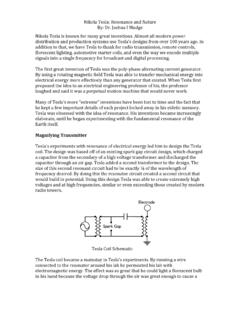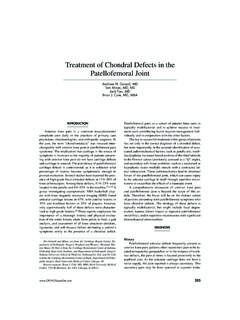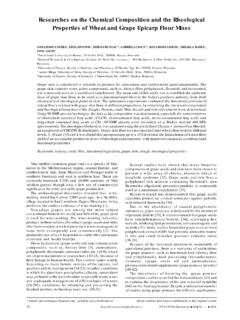Transcription of Principles of NMR - Process NMR Associates
1 - 1 - Principles of NMR By John C. Edwards, Process NMR Associates LLC, 87A Sand Pit Rd, Danbury CT 06810 Nuclear magnetic resonance spectroscopy (NMR) was first developed in 1946 by research groups at Stanford and , in the USA. The radar technology developed during World War II made many of the electronic aspects of the NMR spectrometer possible. With the newly developed hardware physicists and chemists began to apply the technology to chemistry and physics problems. Over the next 50 years NMR developed into the premier organic spectroscopy available to chemists to determine the detailed chemical structure of the chemicals they were synthesizing. Another well-known product of NMR technology has been the Magnetic resonance Imager (MRI), which is utilized extensively in the medical radiology field to obtain image slices of soft tissues in the human body.
2 In recent years, NMR has moved out of the research laboratory and into the on-line Process analyzer market. This has been made possible by the production of stable permanent magnet technologies that allow high-resolution 1H NMR spectra to be obtained in a Process environment. The NMR phenomenon is based on the fact that nuclei of atoms have magnetic properties that can be utilized to yield chemical information. Quantum mechanically subatomic particles (protons, neutrons and electrons) have spin. In some atoms (eg 12C, 16O, 32S) these spins are paired and cancel each other out so that the nucleus of the atom has no overall spin. However, in many atoms (1H,13C, 31P, 15N, 19F etc) the nucleus does possess an overall spin. To determine the spin of a given nucleus one can use the following rules: If the number of neutrons and the number of protons are both even, the nucleus has no spin.
3 If the number of neutrons plus the number of protons is odd, then the nucleus has a half-integer spin ( 1/2, 3/2, 5/2). If the number of neutrons and the number of protons are both odd, then the nucleus has an integer spin ( 1, 2, 3). - 2 - In quantum mechanical terms, the nuclear magnetic moment of a nucleus will align with an externally applied magnetic field of strength Bo in only 2I+1 ways, either with or against the applied field Bo. For a single nucleus with I=1/2 and positive , only one transition is possible between the two energy levels. The energetically preferred orientation has the magnetic moment aligned parallel with the applied field (spin m=+1/2) and is often given the notation , whereas the higher energy anti-parallel orientation (spin m=-1/2) is referred to as.
4 The rotational axis of the spinning nucleus cannot be orientated exactly parallel (or anti-parallel) with the direction of the applied field Bo (defined in our coordinate system as about the z axis) but must precess (motion similar to a gyroscope) about this field at an angle, with an angular velocity given by the expression: o = Bo Where o is the precession rate which is also called the Larmor frequency. The magnetogyric ratio ( ) relates the magnetic moment and the spin number I for a specific nucleus: = 2 /hI Each nucleus has a characteristic value of , which is defined as a constant of proportionality between the nuclear angular momentum and magnetic moment. For a proton, = gauss-1 sec-1.
5 This precession Process generates an electric field with frequency o. If we irradiate the sample with radio waves (in the MHz frequency range) the proton will absorb the energy and be promoted to the less favorable higher energy state. This energy absorption is called resonance because the frequency of the applied radiation and the precession coincide or resonate. Energy Levels for a Nucleus with Spin Quantum Number m = -1/2 m = +1/2 Applied Magnetic Field No FieldEnergy - 3 - We can calculate the resonance frequencies for different applied field (Bo) strengths (in Gauss): Bo (T) 1H Freq (MHz) 60 100 200 300 400 500 The field strength of a magnet is usually reported at the resonance frequency for a proton.
6 Therefore, for different nuclei with different gyromagnetic ratios, different frequencies must be applied in order to achieve resonance . NMR Energies The orientations that a nucleus magnetic moment can take against an external magnetic are not of equal energy. Spin states which are oriented parallel to the external field are lower in energy than in the absence of an external field. In contrast, spin states whose orientations oppose the external field are higher in energy than in the absence of an external field. m = -BoPrecessional orbit around applied magnetic field Spinning Nucleus - 4 - Where an energy separation exists there is a possibility to induce a transition between the various spin states. By irradiating the nucleus with electromagnetic radiation of the correct energy (as determined by its frequency), a nucleus with a low energy orientation can be induced to "transition" to an orientation with a higher energy.
7 The absorption of energy during this transition forms the basis of the NMR method. Other spectroscopic methods, such as IR and UV/Visible, also rely on the absorption of energy during a transition although the nature and energies of the transitions vary widely. When discussing NMR you will find that spin state energy separations are often characterized by the frequency required to induce a transition between the states. While frequency is not a measure of energy, the simple relationship E=h (where E=energy, h=Planks constant, and =frequency) makes this substitution understandable. The statement "the transition (peak) shifted to higher frequencies" should be read as "the energy separation increased".
8 Population Distribution In a given sample of a specific NMR-active nucleus, the nuclei will be distributed throughout the various spin states available. As the energy separation between these states is comparatively small, energy from thermal collisions is sufficient to place many nuclei into higher energy spin states. The number of nuclei in each spin state is described by the Boltzmann distribution : Nupper /Nlower = e- Bo/kT Increasing Magnetic Field Strength Relative Energy BoBom = -1/2m = +1/2I=1/2 - 5 - where the N values are the numbers of nuclei in the respective spin states, is the magnetogyric ratio, h is Planck's constant, Bo is the external magnetic field strength, k is the Boltzmann constant, and T is the temperature. For example, given a sample of 1H nuclei in an external magnetic field of Tesla, then the Population Ratio can be written as: Population Ratio = e(( * * )/( *K 293)) = Thus, at room temperature, the population ratio is This plainly demonstrates that the upper and lower energy spin states are almost equally populated with only a very small excess in the lower energy state that represents spins aligned with the applied field.
9 The population difference is can be calculated as being only about 123 for every 4 million spins. This nearly equal population distribution has a very important consequence. The amount of signal intensity that one will observe in any spectroscopic method is proportional to the population difference between the two energy levels involved. As an example, in UV/Visible spectroscopy, the quantum energy levels have a large energy difference which leads according to the Boltzmann distribution the population residin almost exclusively in the lowest energy state. This means that UV/Visible spectroscopy is an extremely sensitive technique that is typically used in analytical chemistry to deal with very small amounts of sample.
10 In NMR, the energy separation of the spin states is comparatively very small to the point that, at room temperature, while NMR is very informative from a chemistry stand-point, quantum mechanically it is considered to be an insensitive technique. Thus NMR yields relatively weak signals that need to be signal averaged for considerable periods to obtain spectra of adequate signal to noise. This also leads to difficulties in using NMR for trace analysis. Typically NMr would not be considered accurate below a quantitation of wt% (500 ppm). NMR Instrumentation General Overview There are two general types of NMR instrument; continuous wave and Fourier transform. Early experiments were conducted with continuous wave (CW) instruments, and in 1970 the first Fourier transform (FT) instruments became available.





